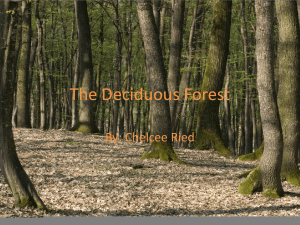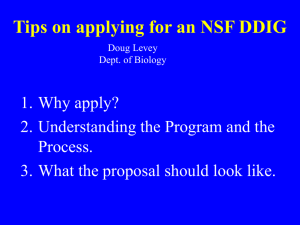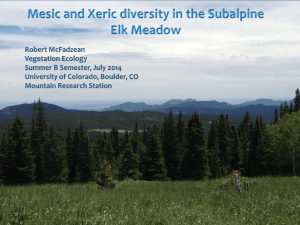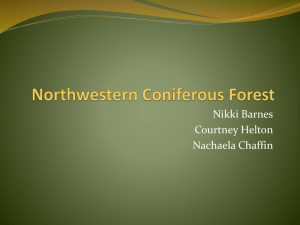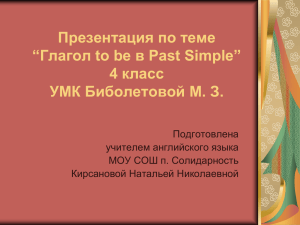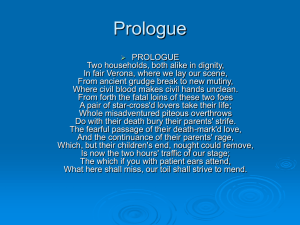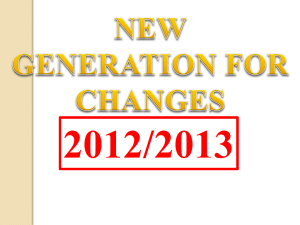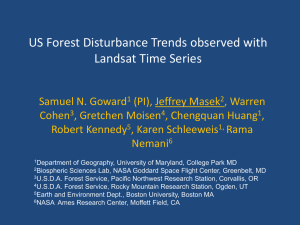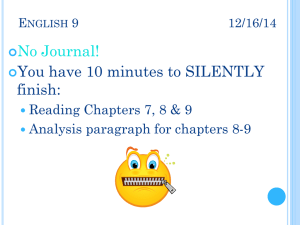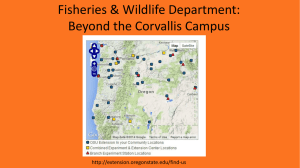1 - Aldo Leopold Wilderness Research Institute
advertisement
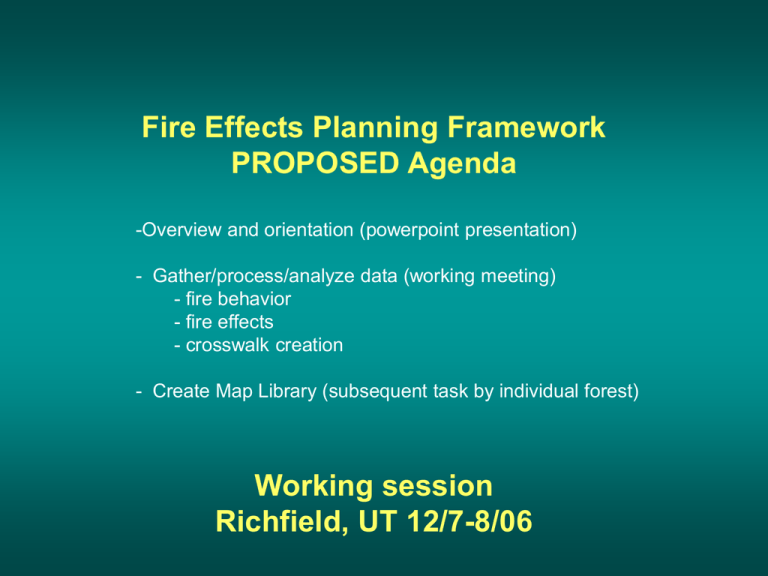
Fire Effects Planning Framework PROPOSED Agenda -Overview and orientation (powerpoint presentation) - Gather/process/analyze data (working meeting) - fire behavior - fire effects - crosswalk creation - Create Map Library (subsequent task by individual forest) Working session Richfield, UT 12/7-8/06 Fire Effects Planning Framework (FEPF) Landscape Dynamics Simulation Models 5 1 Identify resources of interest Identify associated vegetative attributes Update vegetative attributes post-season 3 Crosswalk fire behavior to fire effects on values/objectives Vegetative attributes Fire Behavior Fire Effects Desirability Source Identify fire ecology Species 2 Size/ Structure Crown fire potential 1st Order Fire Effects Effect on whitebark pine Mapping Multiplier Information Source Seed/sap 1, 2, or 3 High Undesirable Effects WB established but not reproducing yet -1 Tomback et al. 2001, FOFEM Model fire behavior Based on FireFamilyPlus weather analysis for Energy Release Component FlamMap 99th% 90th% 4 80th% WB-only Create map library for - land, fuels, fire planning, - AMR/WFU activities • Fire Behavior Extreme – 99% High – 90% Moderate – 80% All except seed/sap 1,2, or 3 High Desirable Effects restore native fire regime +1000 BITTERROOT NATIONAL FOREST Fire Effects Planning Framework Tomback et al. 2001, FOFEM • Effects on Lynx foraging habitat Extreme – 99% 2004 Fire Effects Map Library High – 90% Moderate – 80% • Effects on Whitebark pine Extreme – 99% High – 90% Moderate – 80% 2 or 3 All other species High Highly Desirable Effects provide potential WB habitat +100 Keane, Arno Pers. Comm. Photograph by Steve Sutherland; 2 years post-fire All With the proper input the Fire Effects Planning Framework (FEPF) will give you information on whether a given ignition - will or will not meet a set of objectives. objectives with this ignition? IGNITION input Fire Effects Planning Framework input NFDRS Plans Useful for determining appropriate weather station, key thresholds, i.e. season ending/slowing events. NFDRS Plan Output LMP Objectives Will we meet Land Management Plan Objectives – Where all Forest Service unplanned ignition objectives come from.. Step 1: Gather data and Identify key conditions Fire Weather * weather thresholds (FMP) * weather stations * fire behavior parameter for fire mgmt (ERC, BI, FL …) Resource issues * current and desired condition * map-able attributes species/habitat relationship (wildlife) * fire ecology * fire behavior parameter for effects (ERC, BI, FL …) GIS DATA SETS * Farsite set (topography, fuels, vegetation canopy fuels) * resource data layers Step 2: Model Fire Behavior Weather data Farsite/FLAMMAP (.txt) FireFamilyPlus Threshold %’s 80, 90, 99th% Seasonal %’s .wnd, .wtr, .fms Fuels data (LANDFIRE) PVTGROUP 1 Vegetation/ Imagery 2 3 4 PVT GROUP NAME Upper Subalpine Forest Lower Subalpine Forest - Mesic Canopy Fuels HT_GRP G1,G2 D3, E2 Lower Subalpine Forest - Xeric F1, F2 Upper Montane Forest - Mesic C2, D2 Fuel Model Upper Montane Forest - Xeric C1 6 Lower Montane Forest - Mesic B2, B3 7 Lower Montane Forest - Xeric 8 11 Upper Subalpine Shrub - Herbaceous Lower Montane Shrub - Herbaceous 13 Agricultural 14 Urban/Barren XX4 15 Water XX5 5 Crosswalk A2, B1 NF5 NF1,NF2A, NF2, NF4 XX1 Fuel Model Stand Height Crown Bulk Density Crown Base Height Canopy Cover Step 2: Model Fire Behavior Weather data Farsite/FLAMMAP (.txt) FireFamilyPlus OUTPUTS INPUTS Threshold %’s 80, 90, 99th% Seasonal %’s .wnd, .wtr, .fms Fuels data (LANDFIRE) PVTGROUP 1 Vegetation/ Imagery 2 3 4 PVT GROUP NAME Upper Subalpine Forest Lower Subalpine Forest - Mesic Canopy Fuels HT_GRP G1,G2 D3, E2 Lower Subalpine Forest - Xeric F1, F2 Upper Montane Forest - Mesic C2, D2 Fuel Model Upper Montane Forest - Xeric C1 6 Lower Montane Forest - Mesic B2, B3 7 Lower Montane Forest - Xeric 8 11 Upper Subalpine Shrub - Herbaceous Lower Montane Shrub - Herbaceous 13 Agricultural 14 Urban/Barren XX4 15 Water XX5 5 Crosswalk A2, B1 NF5 NF1,NF2A, NF2, NF4 XX1 Fuel Model Stand Height Crown Bulk Density Crown Base Height Canopy Cover Step 3: Merge to create Fire Effects Crosswalks Species/ Species Mix WB, DF, L, PP, LP, L-mixes, DF-mixes, PPmixes Size/ Structure Fire Severity Fire Behavior Single story Low 1 -1 -1 -1 Single story Mixed 2 1 1 -10 Single or multi-story High 3 -1 10 10 Single story Low 1 -1 -1 -1 Single story Mixed 2 1 1 -10 Single or multi-story High 3 -1 10 10 Single story Mixed 2 1 1 -10 Single or multi-story High 3 -1 10 10 Seed/sap High 3 -1 10 10 All Mixed or High 2 or 3 -10 1 1 No Burn 0 Physical habitat characteristics Mixtures of DF, ES,AF, WB, LP, AL, L, GF Ecological Fire Behavior ES, GF,AL, C, QA, WH, MH, AF, CW Physical Fire Behavior All forested Shrubs 0-14years post-fire 15-39 years post-fire 40+years post-fire Fire effects on target 1 -10 over -10time Non-stocked, nonforest, forbs, grasses All Low, Mixed, No Burn 0,1, or 2 -1 -1 -1 Unburnable, Agriculture, No Data n/a All 0,1,2,or 3 0 0 0 Illustrative only Step 3: Merge to create Fire Effects Crosswalks Species/ Species Mix WB, DF, L, PP, LP, L-mixes, DF-mixes, PPmixes Size/ Structure Fire Severity Fire Behavior Single story Low 1 -1 -1 -1 Single story Mixed 2 1 1 -10 Single or multi-story High 3 -1 10 10 Single story Low 1 -1 -1 -1 Single story Mixed 2 1 1 -10 Single or multi-story High 3 -1 10 10 Single story Mixed 2 Single or multi-story High 3 Stored as 1 set of-10rules or as10 .txt file -1 10 Seed/sap High 3 -1 10 10 All Mixed or High 2 or 3 -10 1 1 No Burn 0 Physical habitat characteristics Mixtures of DF, ES,AF, WB, LP, AL, L, GF Ecological Fire Behavior ES, GF,AL, C, QA, WH, MH, AF, CW Physical Fire Behavior All forested Shrubs 0-14years post-fire 15-39 years post-fire 40+years post-fire 1 Fire effects on target 1 -10 over -10time Non-stocked, nonforest, forbs, grasses All Low, Mixed, No Burn 0,1, or 2 -1 -1 -1 Unburnable, Agriculture, No Data n/a All 0,1,2,or 3 0 0 0 Illustrative only Step 3: Merge to create Fire Effects Crosswalks Species/ Species Mix WB, DF, L, PP, LP, L-mixes, DF-mixes, PPmixes Size/ Structure Fire Severity Fire Behavior Single story Low 1 -1 -1 -1 Single story Mixed 2 1 1 -10 Single or multi-story High 3 -1 10 10 Single story Low 1 -1 -1 -1 1 1 -10 -1 10 10 Physical habitat characteristics Mixtures of DF, ES,AF, WB, LP, AL, L, GF FOFEM 2 Single or multi-story High FVS-FFE 3 Ecological Fire Behavior SIMPPLLE Single story Mixed 2 ES, GF,AL, C, QA, WH, MH, AF, CW WHRM Single or multi-story High 3 URM Physical Fire Behavior Seed/sap High 3 All forested Publications All Mixed or 2 or 3 Shrubs Expert Systems High Single story Mixed No Burn 0 0-14years post-fire 15-39 years post-fire 40+years post-fire Stored as 1 set of-10rules or as10 .txt file -1 10 1 -1 10 10 -10 1 1 Fire effects on target 1 -10 over -10time Non-stocked, nonforest, forbs, grasses All Low, Mixed, No Burn 0,1, or 2 -1 -1 -1 Unburnable, Agriculture, No Data n/a All 0,1,2,or 3 0 0 0 Illustrative only Step 4a: Create Fire Behavior Library FlamMap 99th% Crown Fire Potential Rate of Spread Fireline Intensity 90th% 80th% Step 4b: Create Fire Effects Library Restoration/Fuels Fire Behavior Library 99th% 90th% 80th% Lynx Aquatics Fire Fighter Safety Cavity Nester Initial vegetation Fire effects on vegetation Lynx habitat Fire effects on Lynx habitat Uses: Set fuel treatment priorities Fire Effects Library 99th% 90th% 80th% Uses: Model alternatives and future consequences This example shows use of SIMPPLLE FVS-FFE can also be used. Uses: Go/NoGo (WFIP analyses) cost containment Quantify benefits or reductions in risk within MMA Incident Support Consider potential benefits when determining suppression strategy by flank Maps are draft, and illustrative only Uses: Map Library for Fire Planning BITTERROOT NATIONAL FOREST 2004 Fire Effects Map Library • • Fire Behavior Fire Effects Fire Effects Planning Framework Working session Resources FEPF website search on Fire Effects Planning Framework User’s Guide Bitterroot Map Library Fire Behavior Examples Flammap (Bitterroot) Farsite (Dixie) FOFEM/ expert opinion (Yellowstone NP) Resource Examples Lynx (Bitterroot) Ponderosa pine (Dixie) Aspen (Dixie) Whitebark pine (Bitterroot, Yellowstone) http://leopold.wilderness.net/research/fprojects/fepf/ Richfield, UT 12/7-8/06 What does it really take to make this work? • • • • Resource Objectives (conf. call, meeting) Weather (station, time period) Vegetation data (local vs. LANDFIRE) Calibration (vegetation, fire behavior, fire effects)
